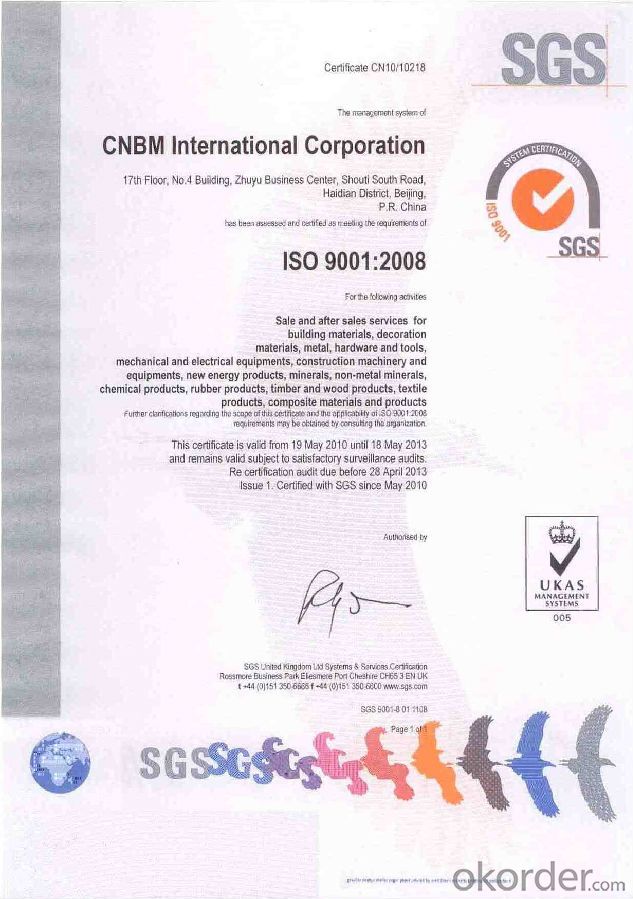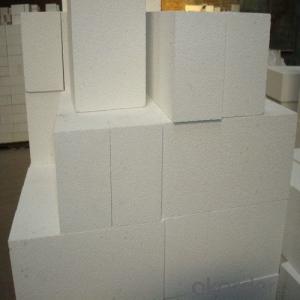Insulating Fire Brick GJM26 Light Weight and Low Thermal Conductivity
- Loading Port:
- Tianjin
- Payment Terms:
- TT OR LC
- Min Order Qty:
- 1 m.t.
- Supply Capability:
- 20000 m.t./month
OKorder Service Pledge
OKorder Financial Service
You Might Also Like
General Information of Insulating Firebricks
CMAX insulating firebricks are classified under temperature between 1300℃ to 1700℃, manufactured from high purity alumina clay.
Feature of Insulating Firebricks
Light weight and low thermal conductivity
Low heat storage
Low iron and impurities
High thermal shock resistance
Application of Insulating Firebricks
CMAX insulating firebricks can be used as a hot face lining directly exposed to the heat or as a backup insulation layer in iron and steel mills, non-ferrous foundries, petrochemical, ceramic, glass.
Images of Insulating Firebricks


Technical Data of Insulating Firebricks
INSULATING FIRE BRICK---GJM26
Classification Temperature (℉/℃) 2600/1430
Bulk Density (g/cm3) ≤0.8
Thermal Conductivity
800℃, W/m.K ≤0.35
1000℃, W/m.K ≤0.39
1200℃, W/m.K ≤0.43
Reheating Linear Change (%) 1410℃×12h
≤0.7
Chemical Composition (%)
Al2O3 ≥55
Fe2O3 ≤0.7
Company Introduction
Who CNBM is
CNBM is a Fortune 500 and a governmental owned National Building Material company in Beijing, China.
What CNBM Can Do
We can supply ALL KINDS OF REFRACTORIES BRICK/CASTABLE and CERAMIC FIBER PRODUCTS in high quality and competitive price.
What Certification CNBM Have

FAQ
If I need your offer, what information do you need?
In order to choose suitable products, it will be appreciated to provide us the information, such us specification, technical data, order quantity, products application etc.
If any question, please contact us freely.
How do you control the products quality?
With strict quality control system throughout the materials selection and production process, our refractory and ceramic fiber products quality is effectively controlled to meet customer requirements.
From the raw materials selecting, our quality control begin. The quality certificates of raw materials are required and each batch will be tested before using. During production, the quality control are conducted by workers and then each piece will be sorted and examined by quality supervisor.
I’m not satisfied with the refractory materials I used before, can you propose more suitable pro
Yes. Please give us the problems you faced, your requirements and the technical data of the products you used before. That we will give you our suggestion and propose the solution based on your special requirements.
What’s the lead time for my order?
It depends on customers’ requirements and our production schedule. And usually we need 30-60 days for refractory bricks,10-25 days for unshaped refractory materials and 10-20 days for ceramic fiber blankets.
Can you offer Door-to-Door delivery?
Yes, but only for some countries such us U.S., UAE, Saudi Arabia, Iran, and Russia, etc.
What is the minimum quantity?
There is no minimum order quantity. Depending on the item and processing, there may be a minimum production required, however we can offer a quotation based only on the quantity you need.
- Q:How do insulating fire bricks affect the overall noise reduction of a structure?
- Insulating fire bricks play a vital role in decreasing the overall noise levels within a structure. These bricks are specially designed to possess exceptional sound absorption properties, rendering them highly efficient in diminishing noise transmission. The insulating fire bricks, characterized by their high density and low porosity, possess the capability to effectively absorb and dampen sound waves. As the sound waves pass through these bricks, the material's internal friction converts the wave energy into heat. This conversion process aids in minimizing sound transmission, resulting in a more tranquil atmosphere. Moreover, insulating fire bricks are renowned for their thermal insulation properties, which indirectly contribute to noise reduction. By maintaining a stable temperature within the structure, these bricks prevent material expansion and contraction, which can generate unwanted noise. It should be noted that the impact of insulating fire bricks on noise reduction can vary depending on the specific construction and design of the structure. To achieve the desired level of noise reduction, factors such as brick thickness, placement, and the presence of other sound-absorbing materials should be considered. To summarize, insulating fire bricks make a significant contribution to reducing noise in a structure by absorbing and dampening sound waves. Their ability to convert sound energy into heat, coupled with their thermal insulation properties, makes them an effective solution for creating a quieter environment.
- Q:Are insulating fire bricks resistant to pests or rodents?
- Insulating fire bricks lack specific design or treatment to resist pests or rodents. Although the dense composition of these bricks may present a greater challenge for pests or rodents to gnaw through compared to other materials, they are not entirely impervious to infestations. To address concerns regarding pests or rodents, it is recommended to adopt supplementary actions like sealing any gaps or cracks in the brickwork, ensuring adequate ventilation, and implementing necessary pest control methods.
- Q:Can insulating fire bricks be used in the construction of smelting furnaces?
- Yes, insulating fire bricks can be used in the construction of smelting furnaces. These bricks are designed to withstand high temperatures and provide excellent insulation, making them suitable for smelting furnaces where heat retention is crucial. They help to minimize heat loss and maintain the desired temperature within the furnace, thus improving energy efficiency and overall performance.
- Q:What is the price of concrete self insulation bricks?
- Insulation brick prices also have a great relationship with the material and workmanship, such as clay brick price is much lower than high alumina brick, mullite and corundum brick prices will be higher.
- Q:Can insulating fire bricks be used for flooring insulation?
- Insulating fire bricks excel in high-temperature scenarios like kilns, furnaces, and fireplaces, but they may not be the optimal choice for insulating flooring. Their softer and less durable nature compared to other flooring materials renders them vulnerable to damage caused by foot traffic. Moreover, they may not provide adequate support and stability for the floor, particularly in areas with heavy foot traffic. To insulate flooring, it is generally advised to use materials specifically designed for this purpose, such as foam boards, cork, or rubber underlayments. These materials possess greater resilience and durability, making them better equipped to withstand the demands of flooring applications. They also offer superior noise reduction and moisture resistance, which are crucial factors to consider when insulating flooring.
- Q:Can insulating fire bricks be used in the construction of hot air generators?
- Yes, insulating fire bricks can be used in the construction of hot air generators. Insulating fire bricks are designed to withstand high temperatures and provide excellent thermal insulation. This makes them suitable for use in hot air generators, which require insulation to maintain high temperatures and prevent heat loss. Insulating fire bricks help to increase the efficiency and performance of hot air generators by reducing heat transfer to the surroundings. Additionally, these bricks are lightweight, easy to install, and durable, making them a popular choice for various industrial applications including the construction of hot air generators.
- Q:Are insulating fire bricks suitable for use in thermal power plants?
- Yes, insulating fire bricks are suitable for use in thermal power plants. Insulating fire bricks are designed to have low thermal conductivity, which means they can effectively retain heat and prevent heat loss. In thermal power plants, where high temperatures are generated, insulating fire bricks can be used as linings for furnaces, boilers, and other equipment to provide thermal insulation and increase energy efficiency. Additionally, these bricks are resistant to high temperatures and can withstand thermal shocks, making them ideal for use in environments with extreme heat. By using insulating fire bricks in thermal power plants, operators can reduce heat loss, increase the overall efficiency of the plant, and improve the durability and lifespan of the equipment.
- Q:Can insulating fire bricks be used in metal smelting furnaces?
- Yes, insulating fire bricks can be used in metal smelting furnaces. These bricks are designed to withstand high temperatures and provide excellent insulation, making them suitable for use in furnaces where metal smelting occurs. They help maintain consistent heat levels and reduce heat loss, allowing for efficient and effective metal smelting processes.
- Q:Can insulating fire bricks be used in refractory lining for steelmaking?
- Yes, insulating fire bricks can be used in refractory lining for steelmaking. Insulating fire bricks are made from lightweight ceramic materials, which have excellent thermal insulation properties. This makes them suitable for use in high-temperature applications such as steelmaking, where maintaining a consistent temperature is crucial. Insulating fire bricks can help to reduce heat loss, improve energy efficiency, and provide insulation against the extreme temperatures experienced in steelmaking processes. Additionally, these bricks are resistant to thermal shock, which is important for withstanding rapid temperature changes during steel production. Therefore, using insulating fire bricks in refractory lining for steelmaking can help to optimize the performance and efficiency of the steelmaking process.
- Q:Are insulating fire bricks eco-friendly?
- To some extent, insulating fire bricks can be considered environmentally friendly. These bricks are typically crafted from abundant natural materials like clay, shale, and other fire-resistant minerals. The manufacturing process involves firing the bricks at high temperatures, which can consume a lot of energy. However, advancements in manufacturing techniques have mitigated the environmental impact by using more efficient kilns and recycled materials. Furthermore, insulating fire bricks boast a long lifespan and can endure high temperatures. This means they require less frequent replacement compared to other brick types, resulting in reduced waste generation and resource consumption over time. Moreover, these bricks possess exceptional thermal insulation properties, which can contribute to decreased energy consumption in various applications. By minimizing heat loss, insulating fire bricks can enhance energy efficiency and reduce carbon emissions in both buildings and industrial processes. Nevertheless, it is crucial to note that the eco-friendliness of insulating fire bricks also hinges on their proper disposal at the end of their life cycle. If not recycled or disposed of appropriately, they can contribute to landfill waste and potential environmental pollution. In conclusion, while insulating fire bricks offer certain environmentally friendly features, such as being made from natural materials and their energy-saving properties, their overall environmental impact also depends on responsible manufacturing, usage, and disposal practices.
1. Manufacturer Overview |
|
|---|---|
| Location | |
| Year Established | |
| Annual Output Value | |
| Main Markets | |
| Company Certifications | |
2. Manufacturer Certificates |
|
|---|---|
| a) Certification Name | |
| Range | |
| Reference | |
| Validity Period | |
3. Manufacturer Capability |
|
|---|---|
| a)Trade Capacity | |
| Nearest Port | |
| Export Percentage | |
| No.of Employees in Trade Department | |
| Language Spoken: | |
| b)Factory Information | |
| Factory Size: | |
| No. of Production Lines | |
| Contract Manufacturing | |
| Product Price Range | |
Send your message to us
Insulating Fire Brick GJM26 Light Weight and Low Thermal Conductivity
- Loading Port:
- Tianjin
- Payment Terms:
- TT OR LC
- Min Order Qty:
- 1 m.t.
- Supply Capability:
- 20000 m.t./month
OKorder Service Pledge
OKorder Financial Service
Similar products
New products
Hot products
Related keywords





























